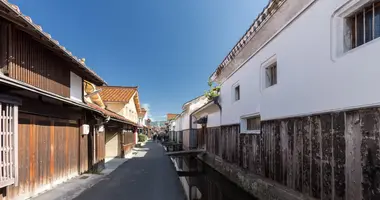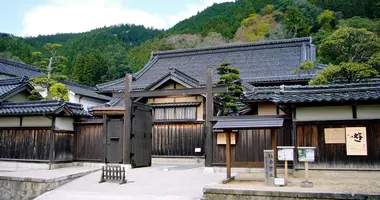Kurayoshi
Kurayoshi, Tottori Prefcture 倉吉市
- History
- Preservation Quarter
- Museums
- Hasedera Temple
- Tottori Nijisseiki Pear Museum
- Lake Togo
- Accommodation
- Access
- Map
- Japan City Guides
Kurayoshi is a small city located in the middle of Tottori Prefecture a little inland from the Japan Sea coast.

Edo Period, white-walled storehouses in the Shirakabe preservation district of Kurayoshi, Tottori
History
In ancient times Kurayoshi was the administrative capital of Hoki Province, the old name for what is now Tottori Prefecture. In the 14th century a small castle stood on Mount Utsubuki overlooking the town. It was destroyed in 1615 and nothing of it remains. During the Edo Period the town prospered as a merchant center servicing the region and this is what created the town's primary attraction, a well preserved merchant quarter with residences, stores and white-walled storehouses.

Historic Merchant Quarter in Kurayoshi
Preservation Quarter
There are plenty of craft galleries and gift shops in the old merchant quarter where you can pick up local specialties and souvenirs.
Ceramics from the eight kilns in the area are for sale as well as bamboo crafts. Items made from the locally produced paper can be bought, especially Hakota Dolls, a local tradition. Of note is a gallery of wooden sculptures by a professional Buddhist statue carver, but the two local products that stand out are the Kurayoshi Ika, a locally made diamond shaped kite, and Kasuri, the local textiles, with finely detailed patterns in indigo woven into the cloth.

Kasuri textiles, the local indigo-colored fabric
In some cases it's possible to see the products being made and also to get a "hands-on" experience. There is a program that includes dressing up in a Kasuri Kimono for your walk around town.
Around the Preservation District are numerous eateries and cafes to stop in at and replenish your energy while exploring the area.

Canal and picturesque lane behind the historic merchant quarter in Kurayoshi, Tottori

Hakota Doll workshop open to the public in Kurayoshi
Museums
The area also has the almost obligatory sake brewery as well as a soy sauce brewery, both of which have products to sample or buy.
There are also a couple of small museums in the district, Kurayoshi Retro Kan focuses mainly on everyday items from the mid 20th century, an era that the Japanese seem inordinately nostalgic for
For those with an interest in sumo, the Kotozakura Memorial Museum is devoted to a local man, Kotozakura Masakatsu, who became the 53rd yokozuna. If you want to explore inside some of the historic buildings that have not been converted to modern use, you have two choices.
The Toyota Family Residence was home to a merchant family that sold kimonos, and the Yodoya, built in 1760 and believed to be the oldest townhouse in Kurayoshi and belonged to the Makita merchant family.
The most picturesque part of the district is actually behind the main street, where a narrow lane follows a small waterway. The sheer white walls of the storehouses and the large slabs of stone that cross the water are very photogenic. There are also several small temples along the lane.
The historic district is in the shadow of Mount Utsubuki, the lower part of which is a huge urban park. With plenty of paths, and a couple of shrines, it is a very popular spot especially during cherry blossom season, though the small animal park is probably best to avoid as it is rather sad and decrepit.

Narrow lane dotted with shrines and temples in the historic area of Kurayoshi

Hasedera Temple, the main hall, perched on stilts overhanging the mountain slope, dates back to the 16th century
Hasedera Temple
On the western slope of the mountain is the only structure left from the time when there was a castle located here.
The main hall of Hasedera Temple is one of the oldest buildings in the region, and though obviously quite important in former times, it is still visited by locals and also by pilgrims on the Chugoku Kannon Pilgrimage.
A ten minute walk from the bus stop, the interior of the hall, which protrudes out from the mountainside, contains many old paintings, and the entrance gate has a fine pair of Nio guardians.

The only Pear Museum in Japan at Kurayoshi Square Park
Tottori Nijisseiki Pear Museum
To the east of the historic district, and easily reachable by bus from there or the station, is the Tottori Nijisseiki Pear Museum, the only one of its kind in Japan.
The museum is located in Kurayoshi Park Square, a modern development with parks, sports and cultural facilities. The museum is large and modern and has displays and exhibits covering all aspects of growing pears, not just in this area but globally.
The cafe in the museum serves a variety of food and drinks made with pears, including ice cream. How much it is worth visiting would depend on how much you want to know about pears, but certainly worth checking out is the atrium next door to the museum.
This soaring structure is constructed out of steel, laminated wood, and glass and would not look out of place in a major city like Tokyo or London.

The interior of the atrium at Kurayoshi Square Park
Lake Togo
Just one station down the line from Kurayoshi is Lake Togo, a scenic lake with hot spring resorts on its shore, and also home to the largest Chinese Garden in Japan, Encho-en.
A little further east, accessible by bus from Kurayoshi, is the only National Treasure in Tottori, the amazing cliff temples of Mitokusan Sanbutsuji Temple.
Accommodation
Kurayoshi is home to many hotels of various kinds and is therefore a convenient spot to base yourself for visiting the surrounding area.
Hotel St Palace Kurayoshi is a western-style three star hotel a 1-minute walk from JR Kurayoshi Station.
Hotel Ark 21 is a three star business hotel also close to Kurayoshi Station with a public bath on the top floor. Free Wi-Fi.
Misasa Royal Hotel has four stars, an open-air hot-spring bath and aromatherapy massages.

Tottori Sand Dunes Conan Airport
Access
Train
Kurayoshi Station is on the JR Sanin Line and is the terminal of the Limited Express Super Hakuto which connects with Kyoto Station in 3.5 hours, Shin-Osaka Station in Osaka in 3 hours, and Himeji in 2 hours.
Whether riding the shinkansen from east Japan (Tokyo) or from west Japan (Fukuoka, Hiroshima), all shinkansen stop at Shin-Osaka. From Shin-Osaka Station the Limited Express Super Hakuto train gets you to Tottori Station in two and a half hours. Japan Rail Pass holders must pay a small surcharge to ride it.
From Tottori Station to Kurayoshi is 30 minutes by Super Hakoto or bout 50 minutes by other trains.
Air
ANA has five flights a day from Haneda Airport to Tottori Airport (nicknamed "Tottori Sand Dunes Conan Airport"), taking about 1 hour 15 minutes.
Bus
Sugizaki Highway Bus operates a night bus service from Tokyo Station (Kajibashi Parking Lot, South Yaesu Exit) to Tottori (across the road from Tottori Central Post Office) that takes about 12 hours and costs about 6,000 yen one-way.
Three bus companies, Keikyu Highway Bus, Nihon Kotsu and Marunouchi Jidosha, operate a night bus service from Shinagawa, Tokyo, (Shinagawa Bus Terminal, outside Shinagawa Station) to Tottori Station that takes about 9 hours 30 minutes and costs about 10,000 yen one-way.
Highway buses also connect Kurayoshi with Osaka and Hiroshima.
Misasa Onsen is 30 minutes by bus from Kurayoshi Station. The bus continues on to Sanbutsuji Temple near Mt. Mitoku.
Car
A rental car is recommended if you want to see the sights in rural Tottori Prefecture.

Tottori Station
Map
Guide Books on Japan
Kurayoshi: read a guide to Kurayoshi city in Tottori Prefecture. It is famous for its well preserved merchant quarter with Edo Period buildings.














